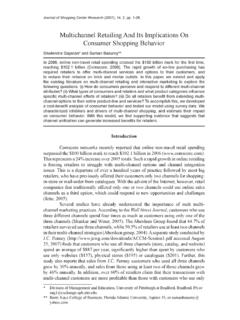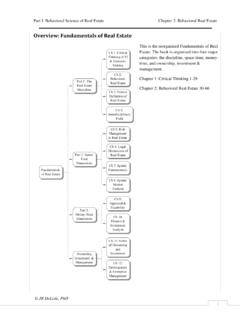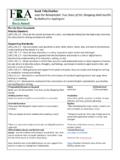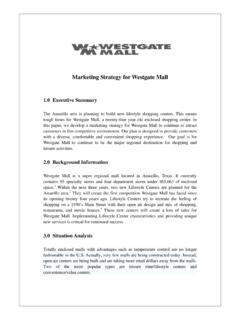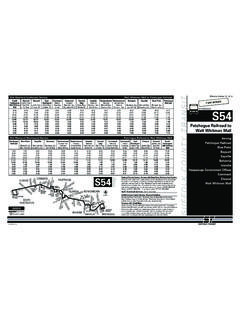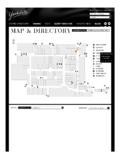Transcription of A Qualitative Study of Mall Shopping Behaviors of Mature ...
1 Introduction As the number and the spending power of Mature consumers grow, they are demanding more attention from mall retailers. However, while Mature consumers have both time and money to spend, they often believe marketers, including retailers, by and large do not have enough understanding to connect with them (Leinweber, 2001). The number of Mature consumers is growing and will keep growing as the largest population cohort the Baby Boomers is reaching retirement age. According to the Census Bureau (2000), there were million Baby Boomers (those born between 1946 and 1964) in 2000 (comprising 28% of the population), and 7,918 of them turn 60 each day. Beyond the growth in numbers, Mature consumers are also gaining wealth. Compared to younger generations, people in Mature households aged 55-64 are reported to have the highest per person discretionary income, averaging $65,000 per year (Lee, 1997).
2 This can be due to a number of reasons, including fewer children present in the household and higher incomes. According to the 2004 Bureau of Labor Statistics Consumer Expenditure Survey, retired households are the most likely segment to own a home without a mortgage, indicating while those households may * Department of Business Administration, Utah State University, Logan, UT or Department of Consumer Science, School of Human Ecology, University of Wisconsin Madison, Madison, WI or Qualitative Study of mall Shopping Behaviors of Mature ConsumersHaiyan Hu* and Cynthia R. Jasper** mall retailers may be discounting the importance of Mature consumers by assuming that Mature consumers are satisfied with their experiences. However, as the Mature consumer segment grows in terms of population and wealth, it becomes increasingly necessary to understand and meet their demands.
3 This Study employed 30 in-depth interviews to understand the Mature consumers mall experience. Overall, the respondents in our Study generally had favorable perceptions of Shopping malls in terms of product selection, convenience, and opportunities for social interaction. We found five elements that are important for Mature consumers to form an impression of the Shopping malls they visited most often: convenience, choice, crowds, ambiance, parking, and hedonic Shopping orientation. Mature consumers in our sample did not reduce their Shopping frequency or the length of their stay for each Shopping trip compared to younger age cohorts; however, they did spend less per trip. Department stores are most often visited by Mature consumers followed by specialty stores and crafts or book stores. When evaluating specific mall attributes, Mature consumers indicated their preference for surface parking.
4 They also suggested that malls need more sitting places. Despite extensive merchandise offerings, they still feel that malls are lacking some of the stores that cater to their lifestyles. They were dissatisfied with service quality in department stores in terms of being understaffed and the salesperson s lack of product expertise. Also interestingly our respondents said they felt younger than their chronological age would indicate. This has implications for the product mix within stores and expectations regarding the appearances of stores within the mall and the mall itself. The managerial implications of the results can aid mall retailers in capitalizing on the Mature market by meeting the needs of Mature consumers. Journal of Shopping Center Research (2007), 14, 1, pp. of Shopping Center Research18 Volume 14, Number 1, 2007have lower incomes, they have higher discretionary income (United States Bureau of Labor Statistics, 2004).
5 Older Americans also hold more than 75% of all financial assets, own almost half the credit cards in the United States, and buy 41% of the new cars (Dychtwald, 1999). According to the smoothing consumption concept of the life-cycle hypothesis, after the age of 65 expenditures should be higher than income, as pre-retirement savings often begin to make up the gap between expenditures and income (Modigliani and Brumberg, 1954). However, this is not the case, as wealthy Mature consumers are not spending their money. The data presented in the Consumer Expenditure Survey indicates that households with the reference person over the age of 65 that have incomes over $50,000 show a disconnect between income and expenditures; on average, at least about $11,000 per year is not being spent (United States Bureau of Labor Statistics, 2004).
6 It is not the case that Mature consumers feel the need to save money either, as Stoller and Stoller (2003) report elderly people generally find their incomes to be adequate, even when those incomes are relatively low. It seems that Mature consumers are the dreams of mall operators, given that on average they have higher discretionary income and are more likely to have time to shop. This could have an impact on the mall sector as it has been in decline in recent years for various reasons (Fickes, 2001). First, the increasing number of Shopping malls offers consumers more options to shop but also fuels the intense competition among Shopping center operators. Second, alternative Shopping venues such as online Shopping and value retailers such as dollar stores have become more popular, as they offer both convenience and price advantages that meet the needs of Americans with less time to shop.
7 Third, boring mall formats deter shoppers who may also be seeking entertainment and excitement while Shopping . As a result, many malls have suffered dwindling foot traffic and more vacancies, contributing to declining sales among mall tenants. Much has been done to address these issues, such as bringing live entertainment into the mall , changing the tenant mix to better cater to local tastes, etc. But more could be done, and in this research we want to call the attention of mall managers to a possible alternative market: Mature consumers. Most mall marketing is targeted to consumers in their teens, 20 s, and 30 s (Lee, 1997). As a result, Mature consumers over the age of 55 are often ignored in the marketplace, and the growing purchasing power of Mature consumers is not being actively harnessed by mall retailers.
8 Although marketers should start to recognize the market potential of Mature consumers, there is limited research available on the experiences of Mature consumers in Shopping malls. This Study is intended to fill this gap by exploring the following research questions: 1. Should mall managers market to Mature consumers? 2. Should the older consumers be treated differently? 3. How can mall managers attract Mature consumers to shop at malls? In the paper, we review the existing studies on Mature consumers in general, as the age of Mature consumers is fairly loosely specified. Specifically, we focus on their lifestyles and consumer behavior and, most importantly, their Shopping behavior. We took a Qualitative approach to collect and analyze interview data from Mature A Qualitative Study of mall Shopping Behaviors of Mature Consumers19consumers regarding their opinions of malls, and we present and discuss the findings to address the implications for mall management.
9 Literature ReviewA number of previous studies have focused on the segmentation of Mature consumers based on chronological age (Goodwin and McElwee, 1999), lifestyles (Moschis, 2003; Shufeldt, Oates, and Vaught, 1998; Sorce, Tyler, and Loomis, 1989) and values (Leinweber, 2001). Some have alluded to the relationship between segmentation and Shopping behavior. For example, Shufeldt et al. (1998) identified five clusters based on the lifestyles of Mature consumers, and examined the relationships between the lifestyle segments and the factors that influence the purchase of over-the-counter drugs. The five clusters are: family-oriented, young and secure, active retiree, self-reliant, and quiet introvert. Furthermore, they demonstrate that quiet introverts tend to enjoy Shopping at Shopping centers, as they get the chance to get out and do something.
10 Unfortunately, these segmentation studies do not provide an understanding of Mature consumers Shopping behavior overall, or, further, how this behavior may differ across various population segments. In the following sections, we review the existing studies that examine the Shopping behavior of older consumers in the following respects: the demographics and psychographics of Mature consumers; store preferences or choices; Shopping behavior; and age-related Shopping concerns. Demographic and Psychographic Characteristics According to Marmon (2003), the Mature consumers over the age of 50 are collectively the wealthiest segment of the population, with more assets and higher home ownership rates than younger groups. Mature consumers aged 55-74 hold 77% of the nation s assets and represent one-quarter of the spending on apparel, dining, entertainment, and household furnishings (Lahue, 2000).
